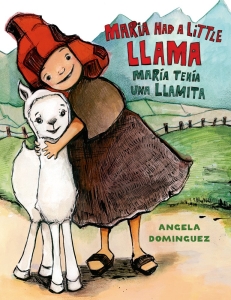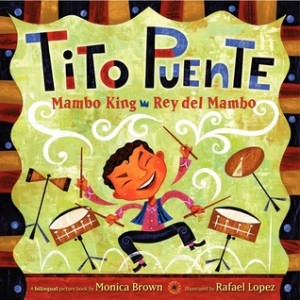Reviews of the 2014 Belpré Illustrator Award winners
Winner: Niño Wrestles the World by Yuyi Morales; illus.
 Winner:
Winner: (Porter/Roaring Brook)
Pint-sized Niño, fearless luchador, Popsicle enthusiast, and reluctantly attentive big brother, dons his red mask (he’s already wearing his orange and yellow sneakers and blue-waistbanded tighty-whities), ready to take on all comers. He battles a series of formidable imagined foes from Mexican history and popular culture, each announced with poster-ready typeface, before facing the trickiest of opponents, las hermanitas! Working in a digital collage that includes watercolor, block print, and photography, Morales packs every polychromatic double-page spread with action, trying, not quite successfully, to contain Niño’s energy within their frames. The saturated palette, dynamic composition, and copious spike-ballooned sound effects add ebullient visual noise. Beneath the furious fun, though, beats a tender heart. Niño’s baby sisters obviously love him to bits, and he is powerless to resist them. In the end, the three join forces, and los tres hermanos are an undeniably unbeatable team. The endpapers, featuring program-style profiles of Niño and all of his competitors, and a final note about lucha libre round out this irresistible outing. THOM BARTHELMESS
 Honor: Maria Had a Little Llama / María Tenía una Llamita by Angela Dominguez, illus. by the author
Honor: Maria Had a Little Llama / María Tenía una Llamita by Angela Dominguez, illus. by the author(Holt)
Maria and her llama smile out at us from the cover of this bilingual picture book, a riff on “Mary Had a Little Lamb.” Maria’s tale, told in English and Spanish, is set in the Peruvian Alps. The bold ink and gouache illustrations include plentiful cultural clues: the market, the village, the traditional headwear, and the musical instruments all help to place readers in the setting. The text mirrors the traditional tale (“He followed her to school one day. / Un dia le siguio a la escuela”), and the limited amount of text allows both languages to appear on the same page or spread. Maria and her llama, though, are the stars of this book. Their personalities and their affection for each other shine through. As if to confirm it, the last spread opens to a scene of children, llamas, and local Peruvian musicians playing and waving as they encircle our two stars dancing in the center. This is a scene young children will return to again and again. JIM ST. CLAIR
 Honor: Tito Puente: Mambo King / Rey del Mambo by Monica Brown; trans. into Spanish by Adriana Domínguez; illus. by Rafael López
Honor: Tito Puente: Mambo King / Rey del Mambo by Monica Brown; trans. into Spanish by Adriana Domínguez; illus. by Rafael López(Rayo/HarperCollins)
A bilingual picture book charts the life of the Mambo King himself, Tito Puente, with all the exuberance of the drummer and bandleader’s irresistible music. Beginning with the opening endpapers, where two children peek through a flame-red theater curtain, Brown and López set the stage for a series of tableaux illuminating highlights in the Puerto Rican musician’s life. The scenes themselves are simple enough—Tito takes music lessons, Tito joins the Navy, Tito goes to Juilliard, Tito wins a Grammy—and are told in straightforward English and Spanish language that lends itself to easy recitation and translation. The vibrant imagery hums right off the page, full of high-contrast color and energetic composition, and decorated with swirling, starry embellishments. The treatment is not especially deep and is decidedly positive: Tito’s life reads like a sequence of successes, each met with acclaim from smiling audiences and enthusiastic animals on every page. While a brief biography as an endnote offers a bit more information, this brash, joyous outing lives to express not the facts of Tito Puente’s life but the spirit of his music. A final rumba beat, in musical notation, captures the story’s irregular refrain: “¡Tum Tica! ¡Tac Tic! ¡Tum Tic! ¡Tom Tom!” THOM BARTHELMESS
 Honor: Pancho Rabbit and the Coyote: A Migrant's Tale by Duncan Tonatiuh, illus. by the author
Honor: Pancho Rabbit and the Coyote: A Migrant's Tale by Duncan Tonatiuh, illus. by the author(Abrams)
Because of a drought, Pancho Rabbit's father heads north for work. When he doesn't return, Pancho goes looking for him, guided by Señor Coyote. What begins as a light allegory becomes a darker tale. Tonatiuh effortlessly employs Spanish words, and folk art–like illustrations complement the story's origin. The author's note on immigration is geared to an older audience. Reading list, websites. Glos. BETTY CARTER
says
Add Comment :-
RELATED
RECOMMENDED
ALREADY A SUBSCRIBER? LOG IN
We are currently offering this content for free. Sign up now to activate your personal profile, where you can save articles for future viewing.







